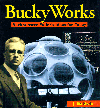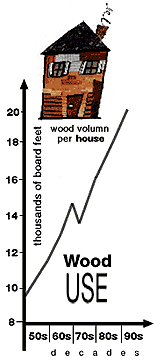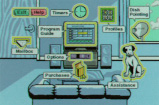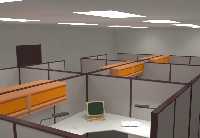by Kirby Urner
First Posted: June, 1996
Version 1.04 (10 October 1997)
© 1996, 4D Solutions
With the publication of J. Baldwin’s superb volume, BuckyWorks, with its detailed and appealing descriptions of the new props we might introduce on the world stage in support of more sustainable, more sharable life styles, the question becomes one of how to move these artifacts from the drawing board or, in many cases, from a realized prototype phase, to full implementation as plentifully supplied assets.

Our situation today in many ways parallels the one confronting the pioneers of the personal computer era just two decades ago. Hobbyists and enthusiasts have seen the future in affordable, technologically advanced housing solutions, but a ‘user friendly interface’ is missing from the picture, such that would-be investors in this technology have no clear pathway into the experience of living in a PillowDome, for example.

The risks and expenses involved dissuade any but the most committed from venturing off the beaten path of Standard Homes and Gardens, as purveyed by the mainstream construction industry and its building codes, zoning laws and attendent Yellow Pages support services (pest control, weatherization, plumbing, remodeling etc).This latter multi-billion dollar industry might be likened to the mainframe culture that dominated all computing prior to the advent of the affordable, personal alternative. Conservative, business-minded individuals simply could not afford to risk their futures on hobbyist solutions as long as Big Blue (IBM) ruled the computing world.
The situation was transformed when IBM itself elected to enter the personal computer market. Today, the Yellow Pages has thickened with entries under Internet and Personal Computer that would have been unthinkable just a short time ago. Surveying the range of technologies poised to enter the popular thinking of our media-saturated culture, we may likewise predict another thickening of the Yellow Pages is about to occur — once the Microsofts and Apples of the new housing revolution emerge from their conceptual (sometimes physical) garages with their new innovations.

The comparison with computers is more fundamental than so far suggested however. As the computer converges with other household devices, such as the television and telephone (and possibly the thermostat and sprinkler system), it becomes less easy to distinguish between the exoskeleton which houses these electronics, and the multi-media internals.

It’s not an over exaggeration to say that the electronics-invested class… is ‘moving in’ to its electronics, in the sense of turning the entire home into some kind of integrated utility box within which the new possibilities and freedoms of cyberspace may be experienced.
The newest, mostly unaffordable homes, have floor plans which accommodate the new American dream of a media room, complete with theater-style, multi-speaker sound systems and large television screens. Beyond this new wrinkle, houses today are expected to accommodate video and data links to the outside world beyond yesterday’s simple telephone and roof-top antenna.Today’s technologies involve cable or satellite dish for receiving video and hi-fi audio, and a high speed data wire, the faster the better (sometimes the fastest solution is not a wire at all, but a wireless connection to the internet). Finally, an increasing percentage of homes play host to networks of more than one computer, configured into a LAN, which generally requires Ethernet cabling or similar wiring solution.
It’s not an over exaggeration to say that the electronics-invested class (the ‘digerati’ as WIRED magazine has taken to calling us) is ‘moving in’ to its electronics, in the sense of turning the entire home into some kind of integrated utility box within which the new possibilities and freedoms of cyberspace may be experienced.
As today’s homes are pressed to accommodate electronics, their shortcomings in this regard become an annoyance. Wiring a home with new circuits, either with conduit for electrical power, or with new data wires, is expensive and means more trips to the Yellow Pages, for all but the handiest. Furthermore, the floor plan may simply not support the optimum arrangement of furniture and appliances to create the media room, home office etc.
The new housing designs suggested by J. Baldwin and company now on the drawing boards will incorporate the kinds of expandable, flexible, configurable modular strategies that coexist most conveniently and economically with the new electronic realities. The ‘personal computer’ and ‘personal work-and-play space’ are in the process of becoming aspects of the same integrated aesthetic.
What would a user-friendly pathway to experiences with the new housing solutions look like? Many would gladly allocate some time and energy trying the new life style and related gadgetry if not in any way coerced to give up what, in many cases, are already very satisfying and ‘dream come true’ domestic situations.
Life in a Fly’s Eye Dome, or some other newfangled dwelling utility, need not begin with some traumatic mile-stone commitment to adopt this new lifestyle ‘forever more.’ On the contrary, the new housing solutions are likely to enter the mainstream in high turnover situations, wherein the dwelling operators come and go, on college campuses for example, or in research settings in the field, where the entire community itself is temporary. Crisis or emergency situations also typically and historically call for novel approaches to providing ‘environment controls’ (a more generic description of the housing function, less likely to evoke stereotypical images of ‘This Old House’).

Another cultural institution wherein life style options are explored, without being adopted as permanent, are the camps and retreat centers, often matched with non-urbanized natural settings. Here people congregate for conferences or trainings in circumstances refreshingly different those found in their everyday lives. Here one might find out what life in a PillowDome could be like.
But the above scenarios all presuppose that high tech housing solutions have already made it off the drawing boards and onto the real world stage. Even accepting their initial transitional role as transitory way-stations in most people’s experience, one must ask how these dwelling machines made it this far along the pathway from science fiction to science fact.
The interim phase, between the imagination and production, is in the digital realm of shared consciousness we now call cyberspace. Using VRML, ray traced imagery, the tricks and techniques of the video-game designer, we can simulate our proposed futures in the form of storyboards.
Storyboards represent the initial ‘comic book’ phase of any modern multi-million dollar movie blockbuster. Before the most expensive resources are committed, artists and writers are commissioned to draw the feature out as a series of ‘mock ups’. Graphics, sounds, sketchy outlines of a plot, all enter in at the storyboard phase.
The outline may be linear, as in the case of an actual comic book, or without any set chronology, as when many options, all inter-related, are being explored. Hypertext, the forte of the internet, provides the underlying ecology wherein such simulations, models and storyboards take root and grow.
Hypertext provides the rich context of cultural symbols, allusions, iconography, stereotypes, precedents, drawn upon by artists working to create the new from the old by means of collage. By juxtaposing the old, the time-worn, the tested, in unfamiliar yet fitting ways, the future is made believable, actual, sometimes almost inevitable.
A significant aspect of the global hypertext is the language of advertising and the imagery and iconography it works to sustain. Corporate logos ornament our most-watched events, appearing in stadiums, on the clothing and vehicles of athletes, everywhere in public space, including on our computer and of course our television screens.



The warp and weave of this corporate logo-language, even more so than the older iconography of national flags, is integral to the business interests and economics of our global culture and defines a layer of shared consciousness that defines a gateway between fantasy and reality. Corporations underwrite and sponsor, they bestow their logos upon projects to betoken their reality. Corporations marshal resources, big time.
The symbolic context surrounding a corporation’s reality-making powers meshes inextricably with its financial well-being. The logo- language of advertising and image-making is all part of the ancient alchemy of manipulating ‘power signs’ according to complicated ‘rules of the game’ in order to conserve and if possible amplify reality-defining powers.
But this hypertext reality is not founded on simply smoke and mirrors. Behind the reality-making powers of corporate iconography are the mathematical sciences of design, including competence with instrumentation and proprietary access to trade secrets. Integral to the longevity and health of an enterprise are its sometimes quasi-invisible armies of service-providers, trained to provide some manner of life support, at least to those in the serviced or provided-for community. Beyond the image-making of advertising is the hard work of prototyping, refining, redesigning, testing, and finally releasing to production or general use (what the computer industry terms the ‘roll out’ phase of a product or solution).
The engineering work needed to sketch the general outlines of our corporate storyboard, in accord with understood technologies and physical principles, often juxtaposed in new ways, has been largely accomplished by now. We already have realistic storyboards showing how humanity might invest in new dwelling technologies within the context of a global service industry supplying educational and work-related programming in a networked ‘human centers environment.’
Every individual is likewise an importer and exporter of information goods, a producer and a consumer. The ability of information to propagate and clone without much additional investment of energy allows for an increasingly ‘ephemeralized’ global economy, in which the traffic in intellectual goods (for example, television programming) coincides with the exponentially increasing ‘knowledge worker’ category.
People will use their dwelling utilities to surf through cyberspace, and, as studios, to edit/recombine the imported content into novel, original contributions to that shared, evolving cultural heritage. This description already characterizes much of what goes on in our current information economy, within the mazes of cubicles that constitute the modern information age corporation. The new dwelling machines enter corporate hypertext precisely here, with this concept of ‘the cubicle.’ With corporate citizens increasingly becoming ‘netizens’ and opting to telecommute from home much of the time, the home receives these new pressures to transform into a wired workspace, with the attendent annoyances sketched above. An innovative corporation might offer its workers the option to telecommute from a ‘pod’ instead of from a ‘cubicle’, or from an inadequate, poorly situated Standard Home.

The interface between high technology companies and the university has become increasingly tight, both geographically and conceptually, to the point where ‘campus’ could mean a setting that is primarily academic, corporate, or both. The appearance of high technology ‘pods’ in place of ‘cubicles’ on the modern corporate-university campus is the storyboarded application we can expect to find making its appearance in reality. In that context, corporate logos will become associated with these new dwelling utilities, both as manufacturers and as providers of these newfangled options to their employe-recruits.
This external manifestation of high technology housing will spark self-amplifying feedback loops in cyberspace which draw in the rest of the storyboard elements, including the emergency deployment, temporary field worker, and retreat center scenarios. The larger picture, of humanity finding itself able to afford sufficient housing to sustain high living standards, thereby bringing down birth rates and slowing population growth, will link via hypertext (e.g. the World Wide Web) to these more immediate and visible implementations.
As a focus for positive hopes and longings of humanity for a better future, the new dwellings will gravitationally attract the logo-language of symbolic reality-making. Corporations will be anxious to affix their brands and symbols to the props and services designed to carry us into a preferred future.
The self-amplifying nature of this relationship between media hype and hypertext, between advertising and engineering, has already been experienced in the explosive growth of the personal computer and information superhighway in our culture.
The here-projected “second round” of this spiral, wherein the “house” and “computer” converge more completely, while the internet becomes more integral to our everyday life style, is just now beginning to take off. J. Baldwin’s BuckyWorks is a first sign of its beginning.
NOTES
For Further Reading
BuckyWorks by J. Baldwin
Other writings by Kirby Urner
- The Project Renaissance Approach to Public/Private Enterprising
- New Circuit Designs for Motherboard Earth
- A Contribution to General Systems Theory
- On Virtualizing Government: A Design Science Approach
- Brainstorming on BuckyWorks (proposed anthology)